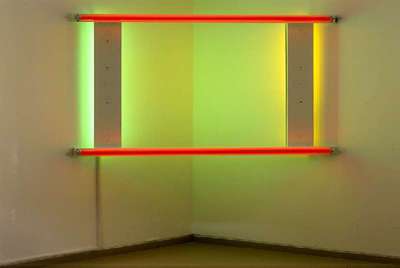Javascript must be enabled to continue!
Untitled (To Bob and Pat Rohm)
View through Europeana Collections
During the 1960s, Flavin shared with other proponents of Minimalism an analytical approach to art that rejected all associative or evocative forms. In each piece of this period, the artist arranged fluorescent tubes in a different constellation, ranging from a single tube positioned diagonally on the wall to more complex compositions: corner pieces, ceiling pieces, light tunnels, and barriers of light. Fellow Minimalist Donald Judd has identified the basic components of a Flavin work: “The fluorescent tubes as the source of light, the light diffused throughout the surrounding space or cast on nearby surfaces, and the arrangement together or placement upon surfaces of fixtures and tubes” (Donald Judd, “Aspects of Flavin’s Work,” in Dan Flavin: fluorescent light, etc. [Ottawa, 1969], pp. 27–28). The light emanating from a work has three sources: the light produced inside the tubes themselves; the light reflected from the fixtures and the surfaces directly around them; and the ambient, or “environmental,” glow, which varies according to the strength and interaction of the colors. Untitled (To Bob and Pat Rohm) is a square corner installation consisting of red fluorescent tubes at the top and bottom of the square, a hidden yellow tube on the right side, and a hidden green tube on the left side. In reference to a similar work, Flavin remarked, “The corner installation was intended to be beautiful, to produce the color mix of a lovely illusion, to render the wall junction above the ‘fact’ of the floor triangle less visible than the usual lighting” (quoted in Dan Flavin: fluorescent light, etc., p. 238).
Title: Untitled (To Bob and Pat Rohm)
Description:
During the 1960s, Flavin shared with other proponents of Minimalism an analytical approach to art that rejected all associative or evocative forms.
In each piece of this period, the artist arranged fluorescent tubes in a different constellation, ranging from a single tube positioned diagonally on the wall to more complex compositions: corner pieces, ceiling pieces, light tunnels, and barriers of light.
Fellow Minimalist Donald Judd has identified the basic components of a Flavin work: “The fluorescent tubes as the source of light, the light diffused throughout the surrounding space or cast on nearby surfaces, and the arrangement together or placement upon surfaces of fixtures and tubes” (Donald Judd, “Aspects of Flavin’s Work,” in Dan Flavin: fluorescent light, etc.
[Ottawa, 1969], pp.
27–28).
The light emanating from a work has three sources: the light produced inside the tubes themselves; the light reflected from the fixtures and the surfaces directly around them; and the ambient, or “environmental,” glow, which varies according to the strength and interaction of the colors.
Untitled (To Bob and Pat Rohm) is a square corner installation consisting of red fluorescent tubes at the top and bottom of the square, a hidden yellow tube on the right side, and a hidden green tube on the left side.
In reference to a similar work, Flavin remarked, “The corner installation was intended to be beautiful, to produce the color mix of a lovely illusion, to render the wall junction above the ‘fact’ of the floor triangle less visible than the usual lighting” (quoted in Dan Flavin: fluorescent light, etc.
, p.
238).
Related Results
Recent Results
Futuro e rigenerazione
Futuro e rigenerazione
Siamo al centro di un processo che ancora ci vede timidi, un po’ impacciati. L’abbiamo inaugurato dieci anni fa, forse più, dicendo che i nostri borghi alpini non potevano continua...
Da terra humana à emergência de um "humanismo" ecológico nas palavras de Davi Kopenawa endereçadas aos brancos
Da terra humana à emergência de um "humanismo" ecológico nas palavras de Davi Kopenawa endereçadas aos brancos
Neste artigo, tomo como ponto de partida a observação de que o livro A queda do céu, do xamã yanomami Davi Kopenawa em coautoria com o antropólogo Bruce Albert, foi elaborado no ch...
Mediation effects of lean mass and fat mass on the relationship between body mass index and handgrip strength
Mediation effects of lean mass and fat mass on the relationship between body mass index and handgrip strength
AbstractObjectiveThis study aimed to assess the mediation effects of lean mass and fat mass on the relationship between body mass index (BMI) and handgrip strength (HGS) in adolesc...
Antecedentes de la vuelta del Guernica a España (1968-1971): las gestiones del director general de Bellas Artes, Florentino Pérez Embid
Antecedentes de la vuelta del Guernica a España (1968-1971): las gestiones del director general de Bellas Artes, Florentino Pérez Embid
Este trabajo pretende mostrar las gestiones realizadas por Florentino Pérez-Embid desde la dirección general de Bellas Artes para traer el Guernica de Picasso a España. En primer l...











 Your session has timed out for security reasons.
Your session has timed out for security reasons.